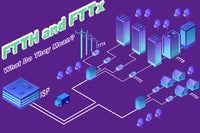(Fiber optic technology has become more and more important in modern life with higher demand for network speed. Take FTTH (Fiber to the Home) as an example, it uses optical fiber to transmit network signals from central points to individual households. FTTH has gradually become popular in broadband internet for their high and stable network speed. Active optical network (AON) and passive optical network (PON) are the two main systems in FTTH and fiber optic networks. What exactly are the differences between them? How do they work? How do you design your fiber network architecture? This blog provides a comprehensive overview of both AON and PON networks.
What is Active Optical Network (AON)?
AON or Active Optical Network is a point-to-point network architecture that delivers network data from the central point to each subscriber, allowing each subscriber to benefit from their own fiber optic line. AON facilitates the direct connection between different devices and nodes, enabling seamless communication and data transfer across the network.
This network system uses many active fiber optic transmission devices like routers or switching aggregators, optical receivers, and optical transceiver modules. Routers and switching aggregators play an important role in signal distribution and data routing. Though AON requires at least one switch aggregator per subscriber, it offers the advantage of hardware interoperability across different manufacturers. AON can reroute the based on the amount of network traffic.
There are three crucial components in AON: optical amplifier, transponder, and modulator. The optical amplifier is used for the enhancement of light amount, which can be either digital or analog. The transponder is used to convert different signal formats, and the modulator is used to transmit optical signals with different wavelengths.

What is Passive Optical Network (PON)?
Developed in the 1990s, PON or Passive Optical Network was aimed to provide data, voice, and video services for users. It helps network operators or Internet service providers (ISPs) serve multiple users by simplifying fiber operations without the need for active power equipment, making it ideal for long-term fiber optic infrastructure. The name PON derives from the use of a passive optical splitter (optical beam splitter) that is used to distribute and route data sent from the Optical Line Terminal (OLT) to multiple end users. This means that each subscriber can access more services but may be affected by the limited bandwidth from the incoming link. PON is future-proof and cost-effective as it reduces the costs of deployment and maintenance, so it is popular with many providers and users. It can be widely found in dense urban areas, FTTH, and FTTB applications.
In the history of PON, there are different variants developed from PON technology. Asynchronous Transfer Mode PON (APON) is the first technology used for ATM packet communication but it has been replaced by later technologies; Broadband PON (BPON) is an upgraded version of APON according to ITU standards and introduces Wavelength Division Multiplex (WDM) technologies; EPON (Ethernet PON) is based on IEEE standards and supports synchronous communication and “three network in one”; GPON or Gigabit PON, was introduced in the early 2000s, represents the latest PON technology and offer high bandwidth, extensive coverage, multiple access services, QoS, and security features such as error correction, encryption, and authentication.

AON vs. PON: What Are the differences?
Both AON and PON are indispensable components of fiber optic networks. Do you know what are the differences between them? Just keep reading for more information.
- Signal Allocation or Bandwidth Capacity
Different signal distributions result in different bandwidth capabilities. Users who choose AON system can enjoy a high bandwidth as their fiber optic line is not shared with other subscribers. This is very different from PON. Passive optical splitters are often used in PON system to distribute signals from one source to multiple destinations, reducing the bandwidth during the transmission. As a result, each subscriber can only get a limited amount of bandwidth.
- Cost
AON uses many powered components including optical amplifiers, repeaters, lasers, optical receivers, optical transceiver modules, and shaping circuits. PON doesn’t use active equipment but requires passive splitters and can work with shared devices. In addition, PON requires less construction and maintenance compared to AON. PON network can be more cost-effective than AON.
- Maximum Distance
The maximum coverage distance of PON and AON is also very different. PON requires users to be close to the center signal source to share the fiber in the network part, so the distance between the CO (central office) and the client can be only up to 20 kilometers. While AON can extend the coverage of around 70 to 100 kilometers, providing dedicated service to each subscriber.
- Scalability
AON requires the installation of the optical interface boards in the tributary nodes to help you expand the network without disturbing the other fiber lines. In contrast, if you want to expand the PON system, it won't be too difficult for you as it only requires minor changes to the fiber optical infrastructure. Passive equipment (passive splitters and combiners) only requires less maintenance. This makes it easy to expand the network by replacing the original splitter with a new one that is capable of distributing more fiber links.
- Security
It should be noted that both AON and PON offer their own security features. AON facilitates the dedicated fiber transmission, so it reduces the possibilities of data interception and mixing. PON only focuses on the encryption and filtering scheme to deter potential eavesdroppers in the downlink transmission. But it can offer single-node and whole-network protections to enhance network security. Single-node protection prevents one node from the failure of other nodes; whole-network protection can provide automatic fiber path switching, and channel and circuit protection.
- Reliability
On the one hand, AON provides flexible management but heavily relies on a continuous power supply for multiple active devices (amplifiers, receivers, transceiver modules, and so on). On the other hand, dedicated AON is always reliable and fast as it can send someone to fix when you make a call or there might be a data leak on the network. PON can work well without the need for power except for the source and destination.
AON vs. PON: Which to Choose?
PON is a cost-effective way to deploy and maintain but may provide limited bandwidth to subscribers, while AON provides a secure solution for large enterprises but requires a lot of initial investment. Both of them are not perfect, so let's look at their pros and cons first.
AON
Advantages
- Great Performance: AON minimizes network latency and delivers high capacity of bandwidth. Active devices used in AON can control the current flow in a circuit to increase the power.
- Long-distance Transmission: AON contains active devices like amplifiers to enhance the signal, which is ideal for long-distance data transmission.
- Security and Privacy: Each subscriber in AON system has an independent transmission line to enjoy high bandwidth network. PON also offers encryption and authentication to maintain security.
Disadvantages
- High Cost and Low Scalability: However, AON requires subscribers to prepare active aggregators for the deployment of AON system and it requires high initial investment to install the network. And it lacks scalability.
PON
Advantages
- Lower Investment: PON requires lower costs in installation and maintenance because of the simplified architecture.
- Energy Efficiency: PON uses multipoint connectivity to serve multiple users by using passive splitters, thus saving space, energy, and
- Flexibility and Scalability: It provides easy network expansion by replacing a new splitter and multiple connectivity options.
Disadvantages
- Hard to Troubleshoot: PON doesn’t rely on active equipment, so troubleshooting can be challenging if a network service outage occurs.
- Decreased Network Speed: When you share bandwidth sent from the single fiber, your network speed may slow down in peak time of network traffic.
- Security Concerns: With shared bandwidth, your network is more susceptible to interference. As a result, it may compromise your data and privacy.
They both have two sides, so the choice depends on your specific needs. AON is more complicated than PON, and it is generally used for applications that require high bandwidth and low latency. AON plays an important role in online gaming, cloud computing, and video conferences thanks to its symmetrical speed. It can also help large businesses enhance network security and privacy. Moreover, AON is a great choice for scenarios that require long-distance fiber optic cable deployment. It is often used in data centers, international enterprise networks, and telecommunication networks.
PON is a preferred choice for scenarios where reliability and cost-effectiveness are needed. It can be found in residential and small commercial applications. For example, PON is well-suited for high-speed transmission in homes, small offices, or rural environments. It is often used in last-mile fiber optic transmission like FTTH and FTTB.
Summary
As the demands for fiber optic networks increase, both AON and PON are developing to shape the future trends of FTTH technologies. In order to make an appropriate choice between PON and AON, you should understand their advantages and disadvantages based on your specific needs. In general, AON is a preferable choice for enterprise-grade applications with its low latency, high bandwidth, and advanced security features. But if you are looking for a cost-effective and high-scalable solution, PON shows its strength.
For more information on this topic, you can keep up on our blogs. While VCELINK offers general and basic information for our customers and other visitors to the website, it’s not professional advice.



Be the first one to comment.
Leave a comment